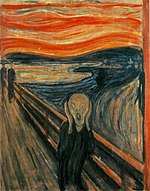Apart from the illuminated manuscripts produced by monks during the Middle Ages, the next significant contribution to European art was from Italy's renaissance painters. From Giotto in the 13th century to Leonardo da Vinci and Raphael at the beginning of the 16th century, this was the richest period in Italian art as the chiaroscuro techniques were used to create the illusion of 3-D space.[8]
Rembrandt: The Night Watch, 1642
Claude Monet: Le Déjeuner sur l’herbe (1866)
Dutch masters
The 17th century witnessed the emergence of the great Dutch masters such as the versatile Rembrandt who was especially remembered for his portraits and Bible scenes, and Vermeer who specialized in interior scenes of Dutch life.Baroque
The Baroque started after the Renaissance, from the late 16th century to the late 17th century. Main artists of the Baroque included Caravaggio, who made heavy use of tenebrism. Peter Paul Rubens was a flemish painter who studied in Italy, worked for local churches in Antwerp and also painted a series for Marie de' Medici. Annibale Carracci took influences from the Sistine Chapel and created the genre of illusionistic ceiling painting. Much of the development that happened in the Baroque was because of the Protestant Reformation and the resulting Counter Reformation. Much of what defines the Baroque is dramatic lighting and overall visuals.[9]Impressionism
Impressionism began in France in the 19th century with a loose association of artists including Claude Monet, Pierre-Auguste Renoir and Paul Cézanne who brought a new freely brushed style to painting, often choosing to paint realistic scenes of modern life outside rather than in the studio. This was achieved through a new expression of aesthetic features demonstrated by brush strokes and the impression of reality. They achieved intense colour vibration by using pure, unmixed colours and short brush strokes. The movement influenced art as a dynamic, moving through time and adjusting to new found techniques and perception of art. Attention to detail became less of a priority in achieving, whilst exploring a biased view of landscapes and nature to the artists eye.[10][11]
Paul Gauguin: The Vision After the Sermon (1888)
Edvard Munch: The Scream (1893)







